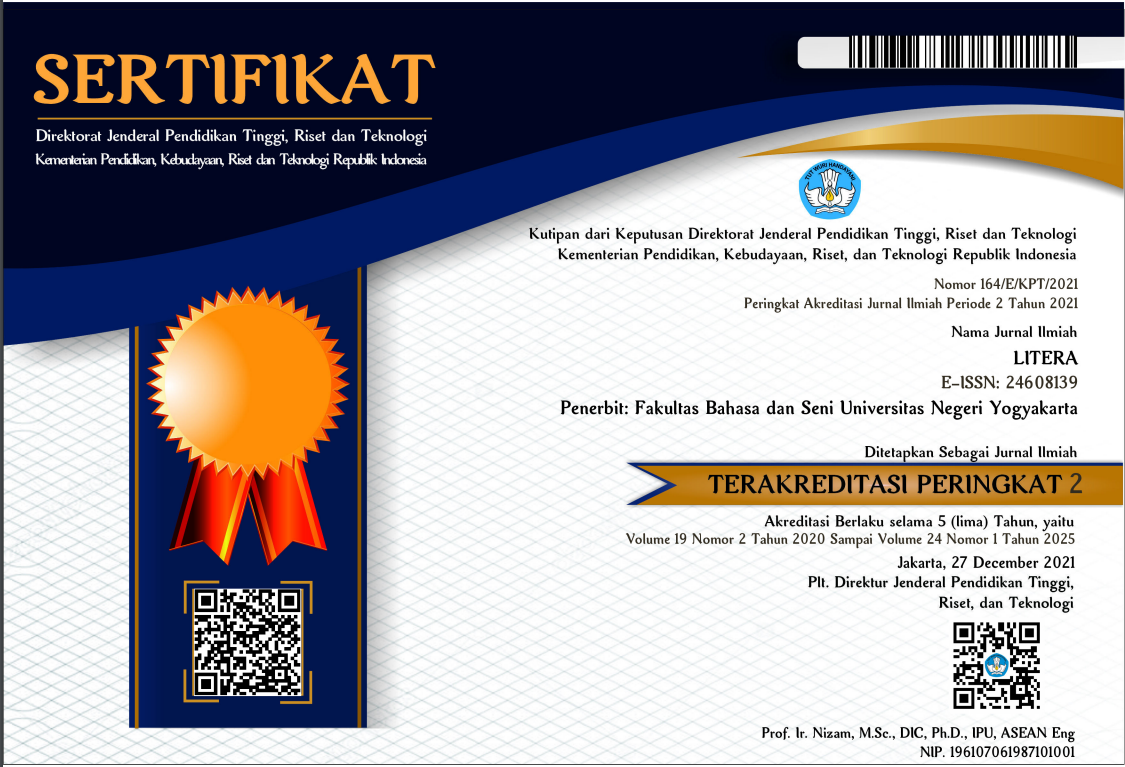MULTICULTURAL VALUES IN INDONESIAN NOVELS OF THE 2000s
wiyatmi Wiyatmi, FBS UNY, Indonesia
Abstract
This study was aimed at describing multicultural values, ways of expressing
multicultural values, and the dynamics of multicultural values in Indonesian novels of
the 2000s. The study purposively selected a sample of six novels that intensely carried the
theme of multiculturalism. These were Laskar Pelangi, Larung, Jendela-jendela, Ayat-ayat Cinta,
Jepun Negerinya Hiroko, and Partikel. The study used the descriptive qualitative method.
The study obtained the following findings. First, there were four main multicultural
values: (a) apreciasion of cultural pluralism, (b) valuing of the principles of humanism
and fundamental human rights (FHR), (c) responsibility of the international society, (d)
responsibility of the planet earth. Second, multicultural values are expressed through
narrative elements and become an integral part of the entire story. Third, multicultural
values move in the dynamics of locality to nationality and nationality to globality.
Indonesian novels of the 2000s express Indonesian people in the contexts of world nation
and citizens who are multicultural, having appreciative minds towards cultural pluralism,
upholding humanism and FHR, taking responsibilities of sustaining the entirety of the
world and planet earth.
Keywords: multicultural, Indonesian novel, nasionality, globality, plurality
Full Text:
PDFReferences
REFERENCES
Basuki, Fira.2001. Jendela-jendela. Jakarta:
Gramedia.
Bhaba, H. 1994. Nation and Naration.
USA & Kanada: Routledge, Taylor &
Francis Group.
Dee (Dewi Lestari). 2015. Partikel. Yogyakarta:
Bentang.
Dini, Nh. 2001. Jepun Negerinya Hiroko.
Jakarta: Gramedia.
Denzin, Norman K., & Lincoln, Yvonna S.
Handbook of Qualitative Research.
Thousand Oaks, London, New Dehli:
Sage Publication International Educational
and Professional Publishers.
El Shirazy, Habiburrahman. 2004. Ayatayat
Cinta. Jakarta:
Basmalah.
Hirata, Andrea. 2005. Laskar Pelangi.
Yogyakarta: Bentang.
http: //www. infofotografi. com/blog.
diakses melalui google.com 25 Juli
http://www.rancahpost.co.id. diakses
melalui google.com 25 Juli 2016.
http:// www.fao.org. diakses melalui
google.com 25 Juli 2016.
http://www.hrw.org. Diakses melalui
google.com 25 Juli 2016.
Imron A.M., Ali. 2007.”Multikulturalisme
dalam Novel Burung-burung Rantau
Karya Y.B. mangunwijaya,” Litera, Vol
, No. 1, hlm. 97.
Parekh, Bhiku. 2001. Rethinking Multiculturalism:
Cultural Diversity and
Political Theory. United Kingdom:
Macmillan Press.
Suparlan, Parsudi. 2002. “Menuju Masyarakat
Indonesia
yang
Multikultural,”
Antopologi
Indonesia, No. 69, hlm.
-99.
Tilaar, H.A.R. 2009. “Pendidikan Multikultural”
dalam
Kekuasaan
dan
Pendidikan.
Jakarta: Rineka Cipta.
Teeuw, A. 1988. Sastra dan Ilmu Sastra.
Jakarta: Gramedia.
Utami, Ayu. 2001. Larung. Jakarta: Gramedia
Pustaka Utama.
Wawa, Jannes Eudes. 2011. “MelayuTionghoa
Bersaudara tanpa Sekat,”
dari http://edukasi.kompas.com/
read/2011/11/25/03273151/MelayuTionghoa.Bersauda
ra.Tanpa.Sekat.
diunduh
melalui google.com 10 Juli
(http://www.infofoto grafi.com/blog).
DOI: https://doi.org/10.21831/ltr.v16i1.14248
Refbacks
- There are currently no refbacks.
______________________
__________________________________________________________________________________________________
Litera Journal is published by the Faculty of Languages, Arts, and Culture Universitas Negeri Yogyakarta in collaboration with Himpunan Sarjana Kesusasteraan Indonesia (HISKI)
The International Journal of Linguistic, Literature, and Its Teaching at http://http://journal.uny.ac.id/index.php/litera/ is licensed under a Creative Commons Attribution-ShareAlike 4.0 International License
__________________________________________________________________________________________________















